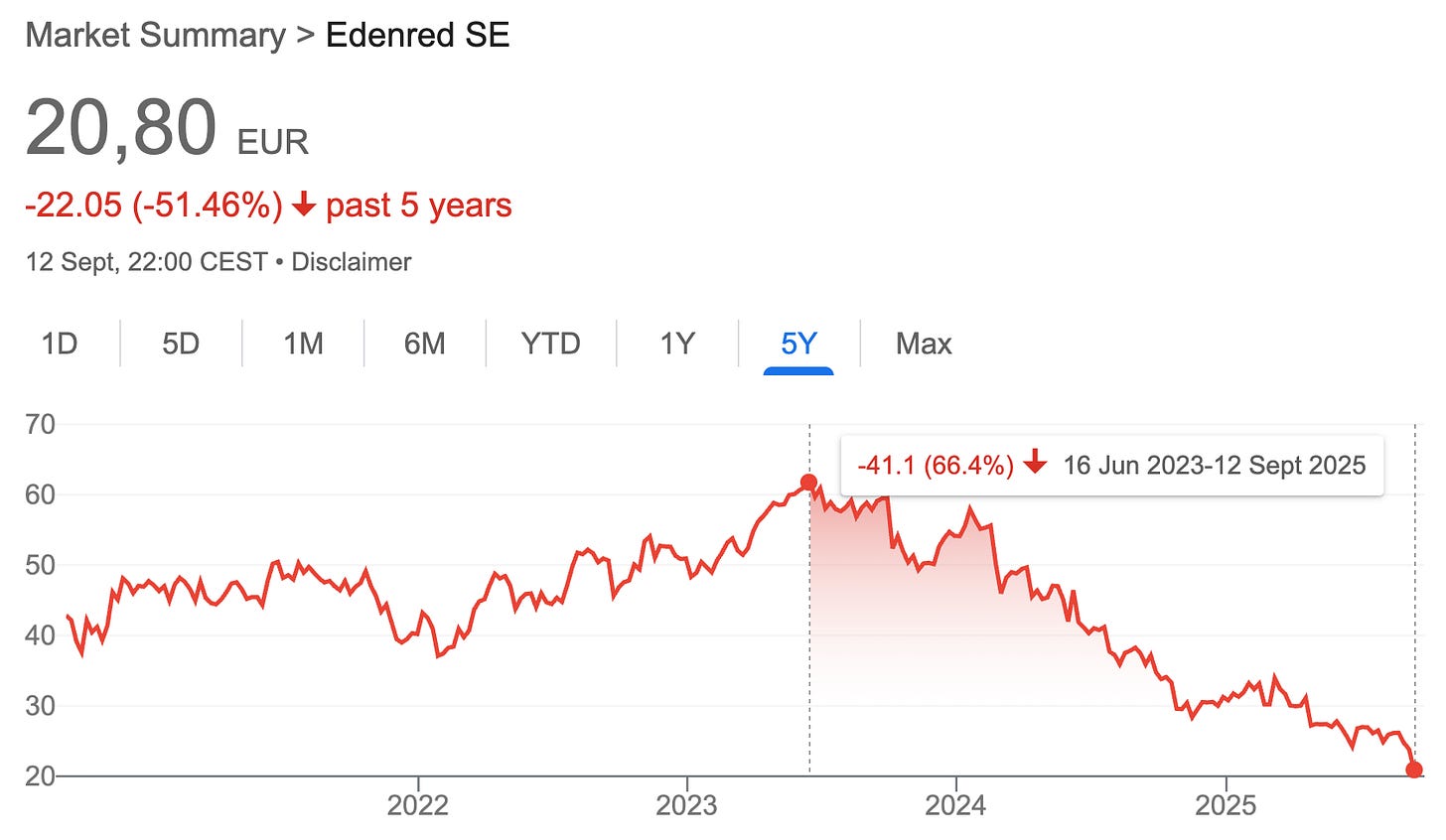Edenred’s Collapse: More Bad News, Worse Sentiment, and What Comes Next
A closer look at the recent storm clouds weighing on Edenred’s stock
There are moments in investing when you feel like the market is piling on, when every headline seems to conspire against a single company. That’s exactly where Edenred finds itself today. The last few weeks have brought a cascade of bad news that together form what looks like a perfect storm. The Turkish antitrust authority has opened an investigation into Edenred and its peers. France, Edenred’s home market, has just been downgraded by Fitch, with debt projected to keep climbing against a backdrop of political fragmentation. And then came the most unsettling rumor of all: a proposed 8% social levy on meal vouchers and other employer-sponsored benefits – a direct hit to the very system that Edenred helped create.
The share price tells the story in numbers. Down nearly 20% in a month. Down more than a third since January. Down two-thirds from the peak in June 2023. For long-term holders, this feels like a nightmare scenario: a business that was once seen as a steady compounder now looks like it’s fighting for air.
But step back for a moment, and the situation is more complicated. Edenred hasn’t suddenly become a worse operator. The business continues to grow in absolute terms, adding clients, expanding geographically, and pushing into new verticals beyond its original meal voucher model. Cash flows remain robust, capital allocation has been disciplined, and the balance sheet is far from distressed. On the surface, Edenred doesn’t look like a company in existential trouble. And yet, markets are treating it as if the ground beneath it might collapse at any moment.
That tension – between a business that looks fundamentally solid and a stock that trades as if disaster is inevitable – is what makes Edenred worth analyzing in depth, and that’s what I already did in my June deep dive:
This post will not just be about this company. Edenred’s story is also a reminder of a broader truth about investing: when you buy into companies that rely on regulatory frameworks or policy-driven demand, you are accepting risks that management can’t fully control. These moats can look unassailable until politics or policy shift, and then you find out the hard way that your margin of safety wasn’t as wide as you thought, the stock not as cheap as it seemed on a trailing basis.
So the real question is not whether Edenred is facing problems – it obviously is – but whether these problems are temporary storms that will pass or whether they point to a deeper structural fragility in its business model. That’s the lens I want to apply in this piece.
Here’s the roadmap of what we’ll cover:
The hidden fragility of regulatory moats – why businesses built on government frameworks can look stable until policy shifts
Edenred as a case study – why the company’s reliance on regulated voucher systems makes it particularly vulnerable to political and fiscal winds
The “perfect storm” of recent bad news:
Turkey’s antitrust investigation into Edenred, Pluxee, and peers, and the business impact
France’s sovereign downgrade and political instability, and how this undermines reforms and stokes uncertainty for Edenred’s home market
The proposed 8% social levy on vouchers, the most direct threat to Edenred’s economics
The math of impact in France – how different levy scenarios could affect Edenred’s revenue, margins, and long-term positioning
Valuation and outlook – updated perspective on Edenred’s valuation profile
The full story starts here:
The rest of this post covers the content outlined above. If you’re serious about sharpening your investing edge, the full post (and all my previous premium content, including valuation spreadsheets, deep dives (e.g. Tiger Brokers, LVMH, Edenred, Digital Ocean, Zalaris, or Ashtead Technologies), and powerful investing frameworks) is just a click away. Upgrade your subscription, support my work, and keep learning.
PS: Using the app on iOS? Apple doesn’t allow in-app subscriptions without a big fee. To keep things fair and pay a lower subscription price, I recommend just heading to the site in your browser (desktop or mobile) to subscribe.




